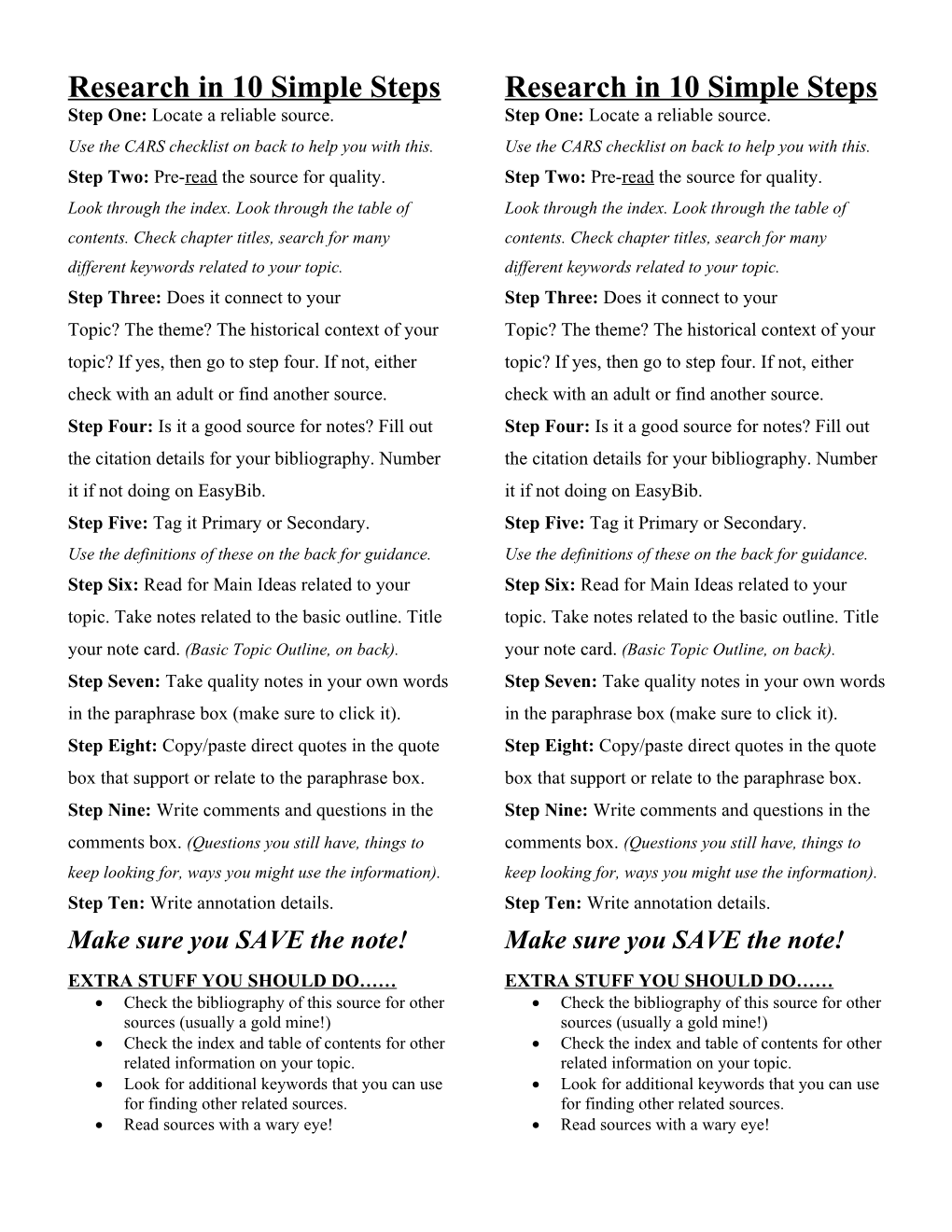Research in 10 Simple Steps
Step One: Locate a reliable source.
Use the CARS checklist on back to help you with this.
Step Two: Pre-readthe source for quality.
Look through the index. Look through the table of contents. Check chapter titles, search for many different keywords related to your topic.
Step Three: Does it connect to your
Topic? The theme? The historical context of your topic? If yes, then go to step four. If not, either check with an adult or find another source.
Step Four:Is it a good source for notes? Fill out the citation details for your bibliography. Number it if not doing on EasyBib.
Step Five: Tag it Primary or Secondary.
Use the definitions of these on the back for guidance.
Step Six: Read for Main Ideas related to your topic. Take notes related to the basic outline. Title your note card. (Basic Topic Outline, on back).
Step Seven: Take quality notes in your own words in the paraphrase box (make sure to click it).
Step Eight: Copy/paste direct quotes in the quote box that support or relate to the paraphrase box.
Step Nine: Write comments and questions in the comments box.(Questions you still have, things to keep looking for, ways you might use the information).
Step Ten: Write annotation details.
Make sure you SAVE the note!
EXTRA STUFF YOU SHOULD DO……
- Check the bibliography of this source for other sources (usually a gold mine!)
- Check the index and table of contents for other related information on your topic.
- Look for additional keywords that you can use for finding other related sources.
- Read sources with a wary eye!
Research in 10 Simple Steps
Step One: Locate a reliable source.
Use the CARS checklist on back to help you with this.
Step Two: Pre-readthe source for quality.
Look through the index. Look through the table of contents. Check chapter titles, search for many different keywords related to your topic.
Step Three: Does it connect to your
Topic? The theme? The historical context of your topic? If yes, then go to step four. If not, either check with an adult or find another source.
Step Four:Is it a good source for notes? Fill out the citation details for your bibliography. Number it if not doing on EasyBib.
Step Five: Tag it Primary or Secondary.
Use the definitions of these on the back for guidance.
Step Six: Read for Main Ideas related to your topic. Take notes related to the basic outline. Title your note card. (Basic Topic Outline, on back).
Step Seven: Take quality notes in your own words in the paraphrase box (make sure to click it).
Step Eight: Copy/paste direct quotes in the quote box that support or relate to the paraphrase box.
Step Nine: Write comments and questions in the comments box.(Questions you still have, things to keep looking for, ways you might use the information).
Step Ten: Write annotation details.
Make sure you SAVE the note!
EXTRA STUFF YOU SHOULD DO……
- Check the bibliography of this source for other sources (usually a gold mine!)
- Check the index and table of contents for other related information on your topic.
- Look for additional keywords that you can use for finding other related sources.
- Read sources with a wary eye!
